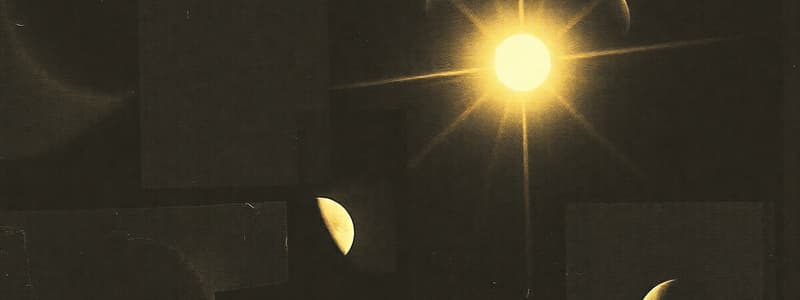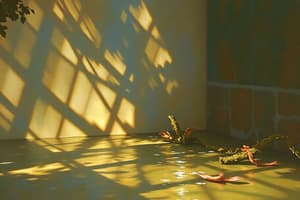Podcast
Questions and Answers
What condition is necessary for a shadow to form?
What condition is necessary for a shadow to form?
- The object that casts the shadow must be translucent.
- A luminous object must be present.
- The light source must be opaque.
- There must be a screen or wall to cast the shadow. (correct)
At which time of day are shadows typically identified as longest and faintest?
At which time of day are shadows typically identified as longest and faintest?
- In the early morning and late afternoon. (correct)
- In the evening when the Sun sets.
- During the midday when the Sun is at its highest angle.
- Noon when the Sun is directly overhead.
Which description aligns with what happens during a solar eclipse?
Which description aligns with what happens during a solar eclipse?
- The Sun casts its shadow on Earth.
- Earth blocks the Sun's light from the Moon.
- The Moon obstructs sunlight from reaching Earth. (correct)
- The Moon's shadow falls on the Sun.
How are materials classified based on light passage?
How are materials classified based on light passage?
What is the result of the Earth’s revolution around the Sun?
What is the result of the Earth’s revolution around the Sun?
Flashcards
Source of Light
Source of Light
Anything that produces light.
Luminous Object
Luminous Object
An object that emits its own light.
Non-luminous Object
Non-luminous Object
An object that cannot produce its own light.
Opaque Object
Opaque Object
Signup and view all the flashcards
Shadow
Shadow
Signup and view all the flashcards
Lunar Eclipse
Lunar Eclipse
Signup and view all the flashcards
Solar Eclipse
Solar Eclipse
Signup and view all the flashcards
Eclipse
Eclipse
Signup and view all the flashcards
Seasons
Seasons
Signup and view all the flashcards
Study Notes
Light Sources and Shadows
- Light sources are objects that emit light, categorized as natural or artificial.
- Objects are classified as luminous (emit light) or non-luminous (do not emit light).
- Materials are categorized as opaque (block light), translucent (allow some light to pass), or transparent (allow most light to pass).
- Opaque objects create shadows—dark patches on the side opposite the light source.
- Shadows need a light source, opaque object, and a surface (screen/wall).
- Shadows are longest and faintest when the light source is at a large angle.
- Shadows are shortest and darkest when the light source is overhead.
- Shadow size and sharpness depend on distance between light source and object.
- Earth's rotation causes day and night.
Eclipses
- Earth's revolution around the Sun causes seasons.
- An eclipse occurs when one celestial body casts a shadow on another, partially or totally.
- Eclipses happen when the Sun, Earth, and Moon are in a straight line.
- Two types of eclipses exist: lunar and solar.
- Lunar eclipses happen when Earth is between the Sun and the Moon, casting its shadow on the Moon.
- Solar eclipses happen when the Moon is between the Sun and Earth, blocking sunlight.
Studying That Suits You
Use AI to generate personalized quizzes and flashcards to suit your learning preferences.




